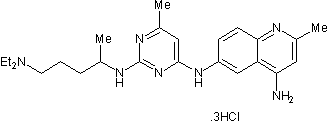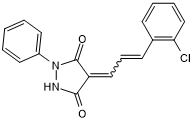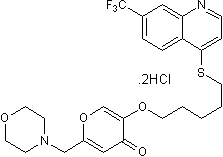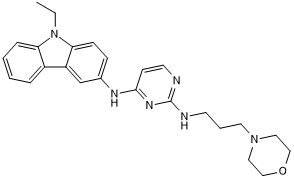Rac1 Products
Ras-related C3 Botulinum Toxin Substrate 1 (Rac1) is a widely expressed member of the Ras superfamily of small GTP –binding proteins. It is included in a subfamily of Ras-related proteins that are botulinum toxin substrates. Two isoforms of Rac1 have been identified. Rac1A is a 192 amino acid (aa) propeptide that is processed by cleavage of thre...
32 results for "Rac1" in Products
32 results for "Rac1" in Products
Rac1 Products
Ras-related C3 Botulinum Toxin Substrate 1 (Rac1) is a widely expressed member of the Ras superfamily of small GTP –binding proteins. It is included in a subfamily of Ras-related proteins that are botulinum toxin substrates. Two isoforms of Rac1 have been identified. Rac1A is a 192 amino acid (aa) propeptide that is processed by cleavage of thre...
| Reactivity: | Human |
| Details: | Mouse IgG1 kappa Monoclonal Clone #CPTC-RAC1-1 |
| Applications: | IHC, WB, ELISA, ICC/IF, MA |
| Reactivity: | Human |
| Details: | Mouse IgG1 kappa Monoclonal Clone #CPTC-RAC1-1 |
| Applications: | IHC, WB, ELISA, ICC/IF, MA |
| Reactivity: | Human, Mouse, Rat, Rabbit |
| Details: | Rabbit IgG Polyclonal |
| Applications: | IHC, WB, ICC/IF |
| Reactivity: | Human, Mouse, Rat |
| Details: | Rabbit IgG Polyclonal |
| Applications: | IHC, WB, ICC/IF |
Recombinant Monoclonal Antibody.
| Reactivity: | Human, Mouse, Rat |
| Details: | Rabbit IgG Monoclonal Clone #JM11-29 |
| Applications: | IHC, WB, ICC/IF |
| Reactivity: | Human, Mouse, Rat |
| Details: | Rabbit IgG Polyclonal |
| Applications: | IHC, WB, ICC/IF |
| Applications: | WB |
| Applications: | ELISA |
| Applications: | PAGE |
| Reactivity: | Human, Rat |
| Details: | Rabbit IgG Polyclonal |
| Applications: | WB, ELISA |
| Reactivity: | Human, Porcine |
| Details: | Mouse IgG2a Kappa Monoclonal Clone #C1 |
| Applications: | IHC |
| Applications: | ELISA |
| Reactivity: | Human |
| Details: | Rabbit IgG Polyclonal |
| Applications: | ELISA |
| Reactivity: | Human |
| Details: | Rabbit IgG Polyclonal |
| Applications: | ELISA |
| Reactivity: | Human |
| Details: | Rabbit IgG Polyclonal |
| Applications: | ELISA |
Selective inhibitor of Rac1-GEF interaction; antioncogenic
| Chemical Name: | N6-[2-[[4-(Diethylamino)-1-methylbutyl]amino]-6-methyl-4-pyrimidinyl]-2-methyl-4,6-quinolinediamine trihydrochloride |
| Purity: | ≥99% (HPLC) |
Rac1 inhibitor; blocks Rac1-P-Rex1 interaction
| Chemical Name: | N-(3,5-Dimethylphenyl)-N'-[2-(trifluoromethyl)phenyl]guanidine |
| Purity: | ≥98% (HPLC) |
DOCK2-Rac1 interaction inhibitor
| Chemical Name: | 4-[3-(2-Chlorophenyl)-2-propen-1-ylidene]-1-phenyl-3,5-pyrazolidinedione |
| Purity: | ≥98% (HPLC) |
Potent Rac family inhibitor
| Chemical Name: | 5-(5-(7-(Trifluoromethyl)quinolin-4-ylthio)pentyloxy)-2-(morpholinomethyl)-4H-pyran-4-one dihydrochloride |
| Purity: | ≥98% (HPLC) |
Rac inhibitor
| Chemical Name: | N4-(9-Ethyl-9H-carbazol-3-yl)-N2-[3-(4-morpholinyl)propyl]-2,4-pyrimidinediamine |
| Purity: | ≥98% (HPLC) |
| Reactivity: | Human |
| Details: | Mouse IgG1 kappa Monoclonal Clone #CPTC-RAC1-1 |
| Applications: | IHC, WB, ELISA, ICC/IF, MA |
| Reactivity: | Human |
| Details: | Mouse IgG1 kappa Monoclonal Clone #CPTC-RAC1-1 |
| Applications: | IHC, WB, ELISA, ICC/IF, MA |
| Reactivity: | Human |
| Details: | Mouse IgG1 kappa Monoclonal Clone #CPTC-RAC1-1 |
| Applications: | IHC, WB, ELISA, ICC/IF, MA |
| Reactivity: | Human |
| Details: | Mouse IgG1 kappa Monoclonal Clone #CPTC-RAC1-1 |
| Applications: | IHC, WB, ELISA, ICC/IF, MA |


![Western Blot: Rac1 Antibody [NB100-91266] Western Blot: Rac1 Antibody [NB100-91266]](https://resources.bio-techne.com/images/products/Rac1-Antibody-Western-Blot-NB100-91266-img0011.jpg)
![Western Blot: Rac1 AntibodyAzide and BSA Free [NBP2-94917] Western Blot: Rac1 AntibodyAzide and BSA Free [NBP2-94917]](https://resources.bio-techne.com/images/products/Rac1-Antibody-Western-Blot-NBP2-94917-img0004.jpg)
![Western Blot: Rac1 Antibody (JM11-29) [NBP2-67091] Western Blot: Rac1 Antibody (JM11-29) [NBP2-67091]](https://resources.bio-techne.com/images/products/Rac1-Antibody-JM11-29-Western-Blot-NBP2-67091-img0007.jpg)
![Western Blot: Rac1 Antibody [NB100-82169] - Rac1 Antibody](https://resources.bio-techne.com/images/products/nb100-82169_rabbit-polyclonal-rac1-antibody-23420241452108.jpg)
![Western Blot: Rac1 Overexpression Lysate [NBL1-15105] Western Blot: Rac1 Overexpression Lysate [NBL1-15105]](https://resources.bio-techne.com/images/products/Rac1-Overexpression-Lysate-Adult-Normal-Western-Blot-NBL1-15105-img0002.jpg)
![ELISA: Human Rac1 ELISA Kit (Colorimetric) [NBP2-82522] - Human Rac1 ELISA Kit (Colorimetric)](https://resources.bio-techne.com/images/products/nbp2-82522_human-rac1-elisa-kit-colorimetric-132202416264327.jpg)
![SDS-PAGE: Recombinant Human Rac1 Protein [NBC1-18385] SDS-PAGE: Recombinant Human Rac1 Protein [NBC1-18385]](https://resources.bio-techne.com/images/products/Recombinant-Human-Rac1-Protein-SDS-Page-NBC1-18385-img0002.jpg)
![Western Blot: Rac1 [p Ser71] Antibody [NBP3-38637] - Rac1 [p Ser71] Antibody](https://resources.bio-techne.com/images/products/nbp3-38637_rabbit-rac1-p-ser-71-pab-912202414123882.jpg)
![Immunohistochemistry-Paraffin: Rac1 Antibody (C1) [NBP3-42114] - Rac1 Antibody (C1)](https://resources.bio-techne.com/images/products/nbp3-42114_mouse-rac1-mab-c1-612202421351238.jpg)






